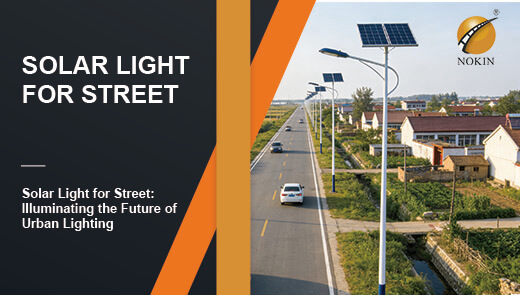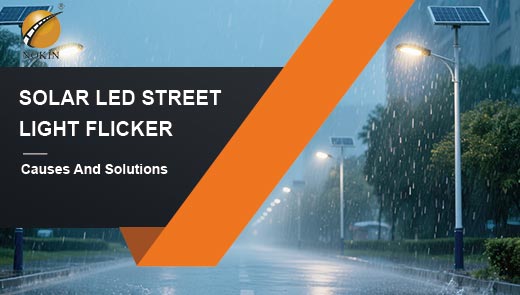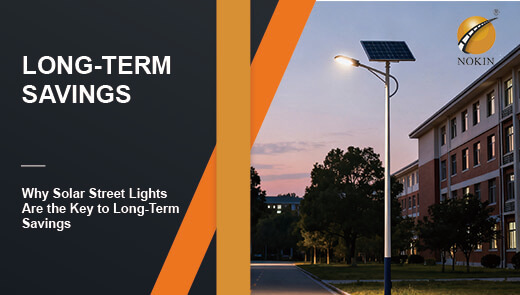Weather and Solar Street Lights Best Practices
In the context of global advocacy of green energy, solar street lights have become a popular choice for road lighting in cities and villages due to their significant advantages of environmental protection and energy saving. This kind of lighting equipment, which utilizes solar energy to convert into electricity, not only reduces the reliance on traditional electricity and carbon emissions, but also saves a lot of costs in the long run. However, the complex and changing weather conditions in different regions have a crucial impact on the performance and service life of solar street lights. In this article, we'll take a closer look at the best practices for solar street lights in all types of weather conditions.
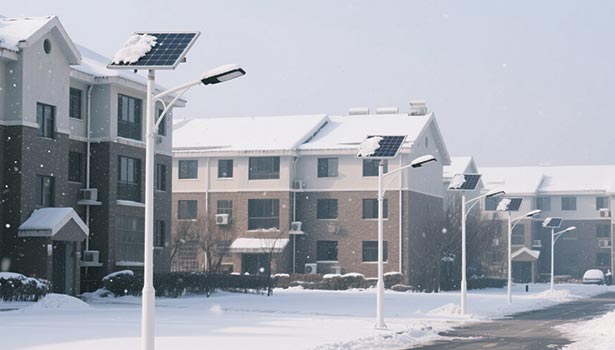
Solar Street Lights in Hot and Sunny Climates
Challenge
The first challenge for solar street lights in hot and sunny areas is overheating of the solar panels. When the temperature gets too high, the efficiency of the panels drops dramatically. Studies have shown that for every 1°C rise in panel temperature, the output power decreases by 0.3% - 0.5%. At the same time, prolonged exposure to strong UV rays will gradually aging the panel materials, resulting in lower photovoltaic conversion efficiency and shorter service life.
How to Overcome These Challenges?
Choose high-temperature-resistant equipment: Choose solar street lights specially designed for high-temperature environments, and use new materials with efficient heat dissipation and anti-aging properties to make the panels, which can significantly improve their working stability under high temperatures.
Flexible adjustment of battery panel angle: install adjustable angle battery panel bracket, according to seasonal and time changes, adjust the battery panel facing and tilting angle, not only to ensure maximum reception of sunlight, but also to avoid overheating caused by direct sunlight in the middle of the day.
Installation of cooling devices: Equip street lights with active cooling systems, such as small cooling fans or liquid cooling pipes. By forcing the heat to dissipate, the temperature of the panels is kept within reasonable limits to ensure their efficient operation.
Add protective coating: Coating the surface of the battery board with special coating of UV protection and high temperature resistance can effectively block the erosion of UV rays on the battery board, reduce heat absorption and extend the service life of the battery board.
Regular Maintenance and Inspection: Establishing a comprehensive regular inspection system to detect stains, cracks and loose wiring on the surface of the panels in a timely manner to ensure that the street lights are always in the best working condition.
Solar Street Lights in Cloudy and Rainy Climates
Challenges
In cloudy or rainy areas, heavy cloud cover acts as a natural barrier, continuously weakening the sun's intensity, resulting in a significant reduction in direct sunlight received by the solar panels and a significant reduction in energy collection efficiency. Continuous days of rainy weather, more so that the panel “power generation is weak”, energy storage system power is difficult to supplement. This directly leads to a decline in the brightness of street lighting at night, shortening the lighting time, dim light is difficult to meet the normal lighting needs of pedestrians and vehicles, for nighttime travel buried security risks.
How to Overcome These Challenges?
Selection of high-efficiency panels: monocrystalline silicon or bifacial solar panels. Monocrystalline silicon panels have a conversion efficiency of more than 22%, which maintains good performance in low-light environments; bifacial panels can utilize reflected light from the ground, increasing power generation by 15% - 25% compared to mono-facial panels.
Equipped with high-capacity battery: equipped with lithium iron phosphate battery, which has high energy storage density and can be charged and discharged more than 3000 times. The high-capacity battery ensures that the street light can work normally under the condition of insufficient light for 5 - 7 consecutive days.
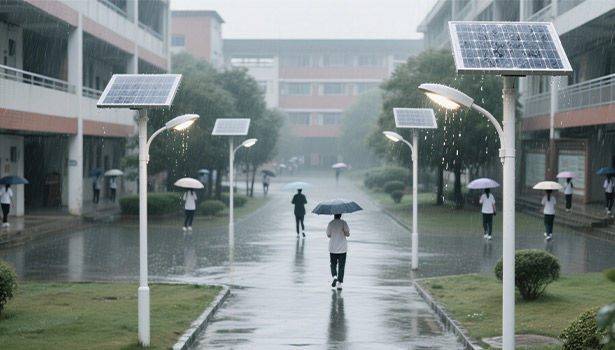
Use of anti-mold shell: the street light shell adopts antibacterial engineering plastics and is fully sealed. This housing can effectively inhibit the growth of mold and mildew and is IP67 rated to prevent rainwater intrusion.
Design of self-draining structure: The surface of the lights and battery panels is inclined, together with the structure of the water-guide groove, to ensure that rainwater is quickly discharged. At the same time, the junction box and other key areas are equipped with waterproof rubber rings to prevent short circuits caused by water accumulation.
Solar Street Lights in Snowy and Cold Regions
Challenges
Snow cover: After a heavy snowfall, the surface of the battery panels is easily covered by snow, which completely blocks the sunlight and prevents the street lights from charging.
Battery performance degradation: The discharge efficiency of ordinary batteries decreases dramatically at low temperatures. For example, the actual capacity of a lead-acid battery at -20℃ may only be 60% - 70% of its capacity at room temperature.
LED Light Failure: Some LED lights may flicker, become unstable or even fail to light up properly under extreme cold conditions.
How to Overcome These Challenges?
Optimize the installation of battery panels: Installation of automatic angle-adjustable battery panels equipped with an intelligent control system, which monitors the thickness of snow in real time through sensors, and automatically adjusts the tilt angle of the panels by gravity or mechanical drive when the snow reaches a certain weight, so that the snow slides down under the effect of its own gravity and ensures that the panels can quickly restore the area of light reception. In addition, the surface of the battery plate is coated with a nanoscale self-cleaning coating, which has super-hydrophobic and super-oleophobic properties that can significantly reduce the adhesion of snow to the surface of the battery plate and reduce the adhesion of snow, which has been tested to increase the speed of snow sliding down by more than 40%.
Selection of low-temperature-resistant batteries: the use of lithium iron phosphate and other batteries with excellent low-temperature resistance, its unique electrochemical properties in the -40 ℃ extreme environment can still maintain more than 80% of the discharge efficiency, compared with ordinary lead-acid batteries in the low-temperature capacity plummeted, can be sustained, stable power supply for the street lights. At the same time, these batteries can be charged and discharged more than 3,000 times, with a service life of up to 10 years, which greatly reduces the frequency of battery replacement and maintenance costs in low-temperature areas.
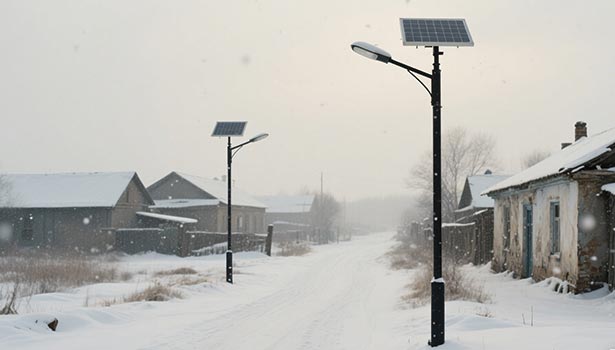
Choosing suitable LED lights: Purchasing high lumen LED lamp modules specially designed for low temperature environment, through special heat dissipation structure design and optimization of low-temperature driving circuit, to ensure that the lights can still maintain stable luminous performance at a low temperature of -30℃, and the luminous flux attenuation is controlled within 5%. Its high lumen characteristics can provide sufficient and stable illumination in cold areas with short days and long nights, effectively improving road safety at night.
Enhanced protection design: The street light adopts all-round waterproof and anti-ice design, with protection level of IP66+, and the seams are sealed with double-layer silicone, which, together with the drainage holes, can effectively prevent water, ice and snow from intruding into the light. The shell is made of high strength low temperature resistant alloy material, through thickening treatment and special structural reinforcement design, it can withstand the stress caused by material contraction in low temperature environment, as well as the pressure brought about by the accumulation of snow and ice to ensure the long-term stable operation of the street light in the severe cold climate.
Solar Street Lights in Windy Areas
Challenges
Strong winds, especially typhoons, hurricanes and other extreme weather conditions, can be extremely destructive. 12-stage typhoons can reach wind speeds of 32.7 - 36.9 meters per second, and the resulting wind pressure can easily shake the structure of ordinary street lights. The pole and overall structure of solar street lights face the risk of being blown over, broken or parts falling off under the impact of strong winds, which will not only cause damage to the equipment, but also pose a serious threat to the safety of pedestrians and vehicles, resulting in great safety hazards.
How to Overcome These Challenges?
Sturdy structural design: In windy areas, street light poles are made of high-strength steel with special wind-resistant design, and some street light poles in coastal areas can withstand typhoons of 12 levels or above.
Stable foundation construction: The streetlight foundation is deeply buried and reinforced by reinforced concrete to ensure that the streetlight remains stable and is not uprooted in strong winds.
Intelligent linkage warning: the intelligent solar street light is equipped with communication module, which is connected with the warning system of the meteorological department. When it receives wind warning information, the streetlight automatically adjusts its posture and retracts some movable parts to reduce wind resistance and minimize the risk of damage.
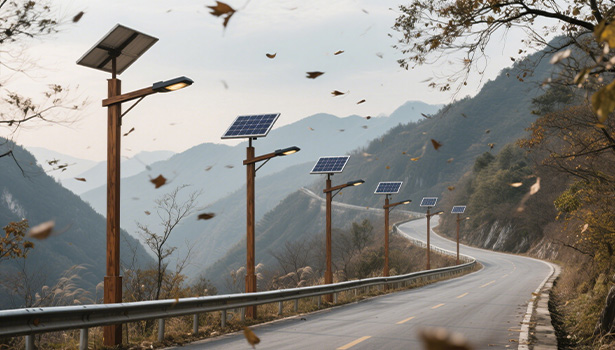
Adaptive Lighting Technology Across Weather Types
Application of Dimming Function
The solar street light with dimming function is equipped with advanced light sensing monitoring and intelligent control system, which can realize accurate and automatic adjustment of light brightness in multiple gears according to the ambient light intensity and battery energy storage condition. When the sun is full and the battery is full, the streetlight operates at 100% full brightness, providing a clear and bright lighting environment for pedestrians and vehicles.
When the light is weakened at dusk, or when the battery power is low due to continuous rain, the streetlight will intelligently reduce the brightness, for example, to 30%-50%, in this way, to meet the basic lighting needs while maximizing energy savings. Taking a certain intelligent dimming solar street light as an example, through this function, its annual energy consumption in areas with unstable light is reduced by more than 35% compared with fixed brightness street lights, effectively improving the efficiency of energy utilization.
Role of Motion Sensor
By installing high-precision motion sensors, the solar street lights are able to monitor the environmental dynamics within a radius of 10-15 meters in real time. When the sensor detects people or vehicles passing by, the street light will quickly and automatically turn on the full brightness lighting within 0.5 seconds to ensure that the passing area is clearly visible; while in the unoccupied period, the street light will automatically switch to 10%-20% low brightness or dormant state, maintaining only a weak indicator light. This intelligent lighting control not only greatly saves electricity, but also effectively reduces the working hours of LED lights, thus extending the service life of street lights. Practical application data show that the replacement cycle of LED lights for solar street lights controlled by motion sensors can be extended from 3-4 years to 5-6 years, which significantly reduces the maintenance cost.
Intelligent Prediction and Automatic Adjustment
With the help of IoT and big data technology, the solar street light can seamlessly connect to the weather prediction system, obtaining accurate weather change data for the next 72 hours in real time. According to the forecast information, the street lights can adjust the lighting strategy in advance: before predicting continuous rainy weather, the system will automatically reduce the brightness of the street lights by 20%-30%, and reserve power in advance to ensure that the basic lighting demand can be maintained in the case of insufficient illumination; when receiving the warning of gale, the intelligent street lights will automatically adjust the posture 1-2 hours before the gale, retrieve part of the movable parts, reduce the wind resistance and strengthen the stabilization system of the light poles, so as to reduce the wind resistance. When a windy warning is received, the smart streetlight will automatically adjust its posture 1-2 hours before the arrival of the wind, retract some movable parts to reduce wind resistance, and strengthen the stabilizing system of the pole to enhance stability.
In addition, if snowfall is predicted, the streetlight will also activate the battery panel heating device in advance to prevent snow cover from affecting power generation efficiency. This intelligent prediction and automatic adjustment function allows the solar street light to actively adapt to weather changes, significantly improving its reliability and stability in complex weather .
Different weather conditions put forward diversified technical requirements for solar street lights. Through scientific selection, rational design and intelligent control, solar street lights are fully able to adapt to various climatic environments. With the continuous progress of technology, solar street lights will contribute to the global green lighting cause with higher reliability and intelligence. In the future, we are looking forward to seeing more innovative technology applications, so that solar street lights can operate stably even in extreme weather.

